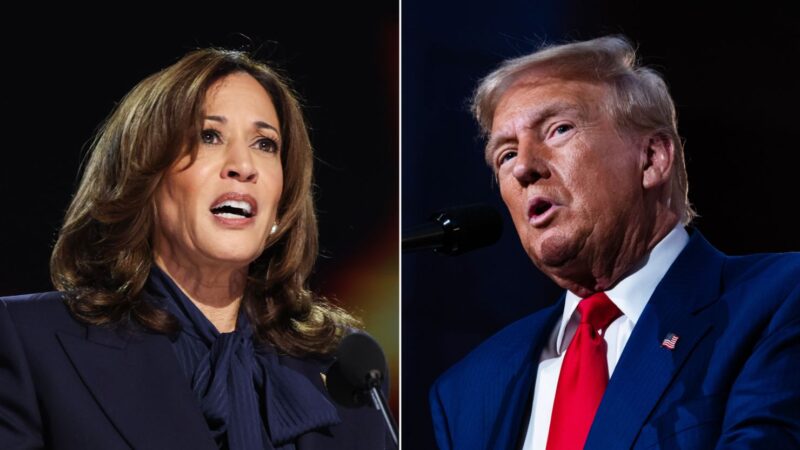The economic plans proposed by Donald Trump and Kamala Harris during their debate present two distinct visions for the future of taxes and financial growth in America. These policies directly impact the financial well-being of Americans across all income levels, including middle-class workers, small business owners, and large corporations. To help you understand how these proposals may affect your salary, taxes, and overall financial situation, we’ll break down each candidate’s plan and its potential impact on your wallet.

Key Takeaways
- Trump’s Economic Plan centers on corporate tax cuts and tariffs aimed at stimulating business growth. However, the trickle-down benefits to individual workers are less certain and could result in higher consumer prices due to tariffs.
- Harris’s Economic Plan focuses on direct tax relief for the middle class, small business owners, and first-time homeowners. This approach offers more immediate financial benefits to a wider portion of the population.
Understanding the financial impact of these policies is crucial for making informed decisions about which plan aligns with your financial goals.
Trump’s Economic Plan: Corporate Tax Cuts and Tariffs
Corporate Tax Cuts
Trump’s plan to continue corporate tax cuts is designed to boost economic growth by giving large businesses more capital to invest in expanding operations, hiring workers, and increasing wages. By reducing the tax burden on corporations, the idea is that these companies will reinvest savings into their workforce, leading to higher salaries and job growth.
Impact on Salaries:
- Potential Benefits: If you work for a large corporation, you could see wage growth or job stability due to increased business investments.
- Delayed Impact: While corporate tax cuts can boost business profitability, studies show that the benefits to employees—such as wage increases—may take time and may not be as substantial as expected.
Impact on Taxes:
- Corporate Profits First: The immediate benefits of corporate tax cuts are mostly felt by shareholders and business owners, as profits increase before they trickle down to employees. This means that average workers may not see significant tax relief in the short term.
- Long-Term Economic Growth: Over time, Trump’s corporate tax cuts aim to fuel economic growth by encouraging companies to expand. However, this growth is less certain for middle-class workers compared to direct tax cuts.
Tariffs
Trump has also proposed imposing or increasing tariffs on imports, particularly from countries like China. These tariffs are designed to protect domestic industries by making foreign products more expensive, encouraging consumers to buy American-made goods.
Impact on Consumer Prices:
- Higher Costs: Tariffs often lead to higher prices on goods such as electronics, clothing, and even food. These increased costs could erode wage gains or disposable income, making it harder for families to manage their budgets.
- Impact on Disposable Income: For many American households, higher consumer prices could offset any potential gains from wage growth or tax savings, meaning less disposable income for savings or spending on leisure.
Harris’s Economic Plan: Middle-Class Tax Relief and Small Business Support
Middle-Class Tax Relief
Harris’s plan prioritizes direct tax relief for middle-class workers, aiming to put more money in the pockets of individuals and families. This approach offers immediate financial benefits by lowering the tax burden on those who earn modest to mid-level incomes.
Impact on Salaries:
- Immediate Relief: Middle-class workers would benefit from increased take-home pay as tax rates for this group are reduced. This provides a direct and measurable improvement in disposable income, which can be used for savings, debt repayment, or other expenses.
- Progressive Approach: Harris’s plan emphasizes progressive taxation, meaning that higher earners may not benefit as much from tax cuts, allowing more relief for middle-class and low-income families.
Impact on Taxes:
- Tax Cuts for the Middle Class: By cutting taxes for workers who make up the largest portion of the economy, Harris’s approach could stimulate economic growth from the bottom up, as more people have money to spend on goods and services.
- Increased Disposable Income: Harris’s plan puts more immediate, direct cash into workers’ hands, increasing their ability to save, invest, or make larger purchases.
Small Business Support
Harris’s economic plan also focuses on providing tax relief to small business owners. This is crucial for promoting entrepreneurship and economic diversity, as small businesses are often the backbone of local economies.
Impact on Small Business Owners:
- Tax Reductions: Harris’s plan could help small business owners by lowering their tax burden, allowing them to reinvest profits into their business, hire more employees, or increase wages.
- Job Creation: By supporting small businesses, Harris’s plan could lead to job creation and wage growth in local economies, providing a boost to middle-class workers.
First-Time Homeowner Benefits
Another significant aspect of Harris’s economic plan is the tax relief for first-time homeowners. This initiative is designed to make homeownership more affordable by reducing the tax burden on families purchasing their first homes.
Impact on Taxes:
- Lower Tax Burden: First-time homeowners could see lower tax bills, making it easier to manage mortgage payments and long-term housing costs.
- Increased Homeownership: By making homeownership more accessible, Harris’s plan could help more families build wealth through property ownership, a key financial asset for long-term stability.
Comparing the Plans: Which One Puts More Money in Your Pocket?
For Middle-Class Workers:
- Harris’s Plan: Middle-class tax relief offers more immediate financial benefits, increasing take-home pay and disposable income without relying on corporate decisions.
- Trump’s Plan: Corporate tax cuts could lead to wage increases, but these benefits may take time to materialize and may be offset by higher consumer prices due to tariffs.
For Small Business Owners:
- Harris’s Plan: Small business tax relief allows for immediate financial flexibility, helping business owners reinvest in growth and hire more employees.
- Trump’s Plan: While Trump’s plan focuses on larger corporations, small business owners may not see as many direct benefits from corporate tax cuts.
For High-Income Earners:
- Trump’s Plan: High earners and business owners could benefit from reduced corporate tax rates, allowing for more significant savings on profits.
- Harris’s Plan: High earners may not see as much tax relief under Harris’s plan, as the focus is on reducing the burden for middle-class workers and small businesses.
Cost of Living Considerations:
- Trump’s Plan: Tariffs could increase the cost of goods, potentially reducing the financial benefits of corporate tax cuts.
- Harris’s Plan: By focusing on direct tax relief and consumer support, Harris’s policies may help offset rising living costs, providing more financial stability for households.
Which Plan is Best for You?
- For middle-class workers and small business owners, Harris’s tax relief policies are likely to offer more immediate financial benefits, allowing for higher take-home pay and increased disposable income.
- For high-income earners and corporate employees, Trump’s focus on corporate tax cuts may lead to long-term wage growth, but the benefits could be delayed or reduced by rising consumer prices.
Ultimately, Harris’s economic plan appears to offer more direct, immediate financial relief for a broader portion of the population, making it the better choice for most middle-class workers and small business owners looking to improve their financial situation.
Stay productive, stay confident, and above all, stay authentic.
Dr. Emily Spencer








